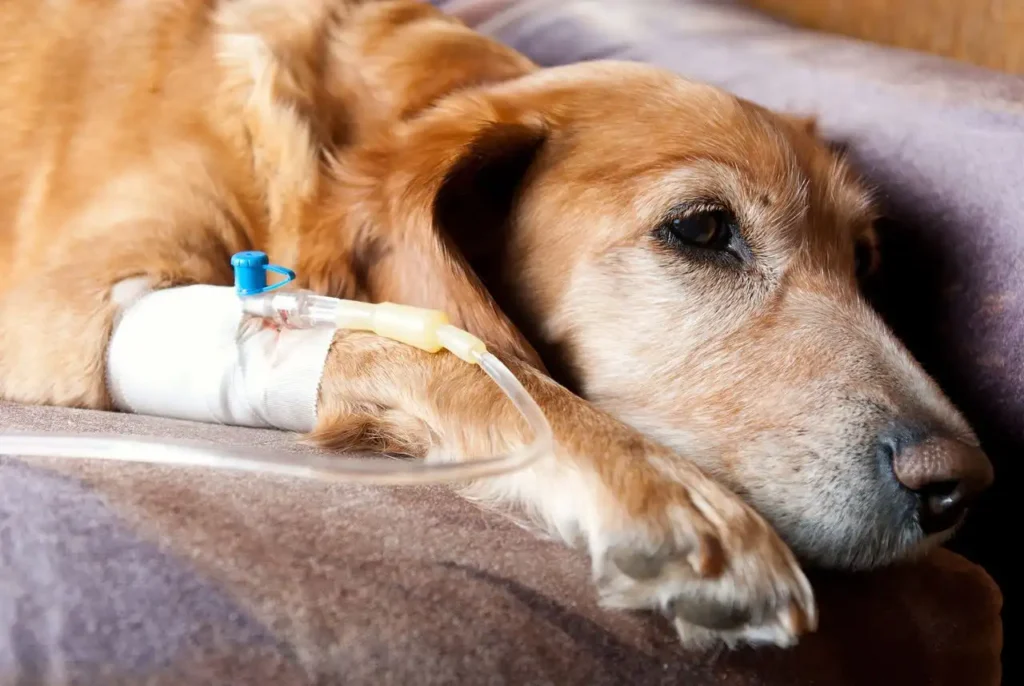Infectious canine hepatitis – symptoms and treatment of the disease

Infectious hepatitis in dogs is a viral contagious disease caused by adenovirus and in acute form, accompanied by pronounced clinical signs. Despite the fact that the pathogen has good resistance to both low and high temperatures, as well as acids, alcohol and chloroform, the disease is not epidemic. Most often, it is observed in the form of rare outbreaks and isolated cases.
Puppies under one year of age are most susceptible to the pathology. Adults over 3 years of age are extremely rarely affected by infectious hepatitis in dogs. Infection is especially common in kennels, where up to 75% of dogs can become infected with hepatitis, of which about 35% die.
Main characteristics of the virus
The causative agent of hepatitis is a DNA-containing virus belonging to the adenovirus family and having the following characteristics:
- virulence: varies among different strains;
- antigenic structure: similar for all strains;
forms of manifestation: hepatitis caused by the CAV-1 virus and adenovirus caused by the second type of virus;
thermal stability: the virus remains viable for 9 months when exposed to a temperature of 4°C, dies after 40 minutes at a temperature of 60°C, and dies after 1 minute when exposed to 100°C.
The hepatitis virus can persist for a long time not only in the excrements, but also in the tissues and organs of a dead animal.
Routes and conditions of infection
The main source of infection is animals infected with the hepatitis adenovirus. Carriers of the disease secrete viruses through conjunctival discharges, the pathogen is present in urine, feces, saliva, and nasal discharge. Direct infection occurs through contact with a virus carrier or an object on which the fruits of its vital activity were left. Potential carriers of infection can be ticks, fleas, and other ectoparasites that have gotten from the fur of a sick pet to a healthy individual.
Infection with infectious hepatitis is alimentary – viruses enter the body through the mucous membranes. Most often, infection occurs through food or drink, ammunition, hygiene items, inventory, bedding, clothing that were previously used to care for an infected dog.
The development of infectious canine hepatitis is facilitated by poor conditions typical of kennels, as well as a number of secondary pathologies:
plague;
toxoplasmosis;
helminthic infestations;
“Olympic jacket”;
chlamydia;
streptococcosis.
Infection and the progression of the disease are affected by hypothermia, the general health of dogs, poor nutrition, and insufficient amounts of vitamins.
Etiology
Entering the body through the oropharynx, the virus accumulates and multiplies in the tonsils, laryngeal mucosa, esophagus and nasopharyngeal tissues. As the pathogenic microorganisms grow, the adenovirus penetrates the regional lymph nodes, from there into the lymphatic vessels and bloodstream. Together with the bloodstream, pathogenic microorganisms spread throughout the body, affecting not only the lymph nodes, but also internal organs and systems.
The highest concentration of exotoxin is observed in the liver. Under the influence of pathogens, inflammation of various organs develops, where degenerative processes occur as the condition of the sick dog worsens. The vascular system also suffers, since the toxic effect of adenoviruses destroys the endothelium, thinning them and increasing permeability.
General and specific symptoms
Specific symptoms help to identify hepatitis infection. As the pathology develops with infectious hepatitis, the dog has difficulty breathing, constant arrhythmia and shortness of breath are observed. During palpation of the abdominal cavity, even with slight pressure, the dog shows anxiety due to pain in the liver area. The peritoneum swells due to developing ascites. Due to regular pain and discomfort, the dog often settles down, taking an unnatural pose – sits, spreading its front paws wide apart.
The functioning of the central nervous system is disrupted. This is manifested by deterioration of movement coordination, frequent cramps or muscle spasms, weakness of the limbs. The listed manifestations are accompanied by severe itching. The dog begins to scratch its entire body.
In the initial stages, viral hepatitis in dogs manifests itself with non-specific symptoms common to many diseases. The animal’s body temperature rises, which remains high for 1 to 6 days. Over the course of several days, the picture worsens and other signs of infection appear:
keratitis of unilateral or bilateral type;
yellowness of the sclera and mucous membranes;
lethargy and apathy;
profuse diarrhea;
increased heart rate;
increased thirst;
frequent urination with a change in the color of urine to a darker color;
loss of appetite;
constant discharge from the nose and eyes;
vomit;
swelling in the area of the lymph nodes and tonsils;
gastroenteritis;
the appearance of mucus and blood clots in the feces;
tonsillitis.
Forms of the disease
Canine hepatitis can develop in different forms. Acute hepatitis is mainly recorded in dogs of different breeds under one year of age that have not been vaccinated. In the acute course, the pathology is manifested by a sharp increase in temperature to 41 ° C and heart rate, which can be more than 100 beats in 60 seconds. Adenovirus affects internal organs and systems with lightning speed. The dog’s urine becomes dark with a brown tint.
The pulse is weakly felt, breathing becomes more frequent and is accompanied by wheezing, occurring in the lower part of the bronchi and in the lungs. The pathology may not be accompanied by other symptoms. In dogs with poor health, death occurs within the first day.

The subacute form of infectious hepatitis lasts about 6 days and proceeds with less pronounced symptoms. If the pathology proceeds favorably, the animal recovers in 2-3 weeks.
Chronic hepatitis can develop latently without characteristic signs for a long period. The dog may experience problems with the digestive organs and intestines, anemia, periodically occurring fever, and enlarged lymph nodes. Vomiting and dyspepsia are sometimes possible.
In acute and subacute forms of the disease, the mortality rate of sick dogs without timely assistance is about 90%. Surviving pets receive persistent and long-term immunity to adenovirus. With chronic hepatitis, it is impossible to completely cure a dog, but with regular medical care, a sick animal will be able to live a normal life.
Possible complications
Dogs that have recovered from viral hepatitis may develop neurological deficits, which are a consequence of damage to brain tissue. In addition, the most common complications include:
liver failure;
chronic diseases of the gastrointestinal tract;
pyelonephritis;
glaucoma;
internal bleeding;
infertility;
cirrhosis;
central nervous system damage.
Diagnostic methods
Considering that hepatitis is accompanied by symptoms characteristic of many other diseases, the pathology requires comprehensive differential diagnostics. To confirm or refute the diagnosis, a urine test is performed. However, it does not allow determining the form of the disease, since even in the chronic course of the disease, the causative virus is released into biological fluids.
For more detailed diagnostics, PCR testing is used to detect the pathogens CAV-1 and CAV-2, by analyzing a smear from the nasal cavity, rectum or conjunctiva. Also, the following is additionally prescribed:
pH and RIF test analyses;
analysis of serological, biochemical and bacteriological blood tests;
Ultrasound with analysis of the condition of organs in the peritoneum;
abdominal radiography;
Treatment
Treatment of infectious hepatitis in dogs is comprehensive and includes therapy aimed at:
Stopping the viability of the pathogen and inflammation by prescribing antiviral drugs and broad-spectrum antibiotics. Additionally, specific immunotherapy is prescribed.
Prevention of dehydration. For this purpose, solutions of colloids and crystalloids are prescribed, which are introduced gradually and with caution to prevent hyperdehydration.
Treatment of hypoglycemia by administering glucose-based solutions.
Along with the main treatment, symptomatic therapy is carried out. In case of vomiting, the dog is prescribed antiemetic drugs. The treatment regimen includes painkillers. In case of eye damage, instillation of drugs that reduce corneal edema and prevent corneal ulceration is indicated.
To stabilize the liver, hepatoprotectors are prescribed. To normalize the work of internal organs, herbal medicine is used: decoction of chamomile, bearberry, St. John’s wort. To restore intestinal microflora, agents containing lactobacilli are given.
Vitamins and antihistamines are prescribed. To speed up the dog’s recovery, enemas are included in the treatment, which cleanse the body of toxins.
In addition to the listed medications, cardiac drugs, glucocorticoids, antipyretics, and adsorbents are used in symptomatic therapy.
Prevention
The basis for preventing hepatitis in dogs is timely vaccination, which can be administered to puppies as early as 6 or 8 weeks, depending on the breed and weight of the dog. For this, both mono- and polyvaccines against infectious hepatitis are used. To consolidate the result, it is necessary to re- vaccinate the animal when the dog turns 1 year old. In the future, regular vaccination according to the schedule and a visit to the veterinarian for a preventive examination will help to avoid infection.



